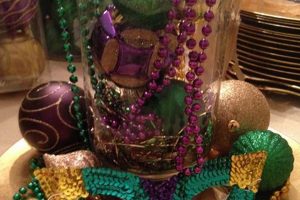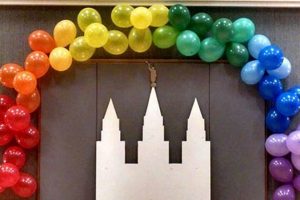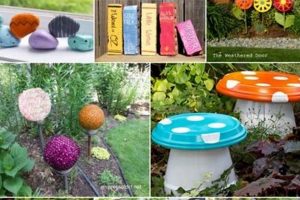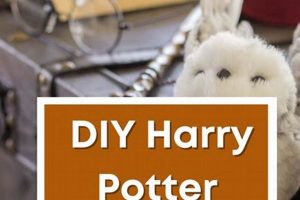The creation of unsettling and macabre fairground-themed adornments through do-it-yourself methods involves crafting decorations that evoke feelings of unease and dread, often associated with traditional carnival aesthetics. Examples encompass hand-painted signs with ominous messages, homemade props like grotesque clown masks, and repurposed vintage items arranged to create a disturbing atmosphere.
This form of crafting offers several advantages, primarily cost-effectiveness and personalization. Commercially produced decorations can be expensive and lack individual character. The do-it-yourself approach allows for the use of readily available, inexpensive materials to generate uniquely terrifying results. Furthermore, it provides an outlet for creative expression and enables the tailoring of decorations to specific themes or levels of scariness. Historically, homemade decorations have been a staple of amateur haunted attractions and Halloween celebrations, allowing individuals to transform spaces on a budget.
The following sections will delve into specific techniques and material choices useful in the construction of these disturbing decorative elements. Considerations for safety, durability, and effective presentation will also be explored, facilitating the construction of compelling and unsettling carnival-themed environments.
Crafting Unsettling Ambiance
The following suggestions aim to guide the creation of a profoundly disturbing carnival environment through effective use of unsettling decorative elements.
Tip 1: Embrace Muted Palettes and Weathered Finishes: Avoid bright, cheerful colors typically associated with traditional carnivals. Instead, favor muted tones like grays, browns, and dark reds. Simulate age and decay through techniques like distressing paint, applying washes, and creating artificial rust effects.
Tip 2: Incorporate Vintage and Repurposed Materials: Source antique dolls, taxidermied animals, and discarded machinery to create a sense of dilapidated grandeur. These items, when artfully arranged, can significantly enhance the creepy carnival aesthetic.
Tip 3: Emphasize Lighting and Shadows: Utilize strategically placed lighting to create areas of intense brightness and deep shadow. Flickering lights, colored gels, and strobe effects can contribute to a disorienting and unsettling atmosphere.
Tip 4: Create Ominous Signage: Design signs with cryptic messages, unsettling illustrations, and distorted typography. These should hint at the dark history of the carnival or the dangers that lie within.
Tip 5: Utilize Soundscapes to Enhance Immersion: Incorporate unsettling sounds, such as distorted carnival music, menacing laughter, and unexplained creaks, to create a truly immersive and disturbing experience.
Tip 6: Introduce Elements of Decay and Disrepair: Integrate elements of deliberate imperfection and disrepair. Ripped fabrics, cracked surfaces, and simulated damage enhance the feeling of neglect and create a sense of unease.
Tip 7: Play with Scale and Proportion: Over-sized props, miniature displays, or distorted reflections can disrupt expectations and contribute to a sense of unreality.
By strategically applying these suggestions, one can elevate the impact of unsettling decorative creations, transforming a mundane space into a chillingly memorable environment.
The subsequent section will cover common pitfalls to avoid when crafting these kinds of decorations.
1. Distressed Appearance
The application of a distressed appearance is fundamental to achieving a convincingly unsettling aesthetic in do-it-yourself creepy carnival decorations. This technique simulates the effects of age, neglect, and damage, contributing to the overall sense of unease and decay typically associated with haunted or abandoned fairgrounds.
- Faux Aging of Materials
This involves artificially recreating the appearance of aged surfaces on newly constructed or repurposed items. Techniques include dry brushing to simulate worn paint, applying antiquing glazes, and creating artificial rust using specialized paints or oxidizing solutions. For example, a newly built wooden sign can be transformed to resemble a decades-old relic through careful application of these methods. This contributes significantly to the sense of historical decay integral to a creepy carnival theme.
- Weathering Effects
Simulating the effects of exposure to the elements is another key aspect of distressing. This can be achieved through techniques like splattering diluted paint to mimic water stains, applying crackle medium to create fractured paint surfaces, and using sandpaper to wear away edges and reveal underlying layers. For instance, plastic props can be made to resemble weathered metal through careful painting and sanding, blurring the line between reality and artifice and enhancing the unsettling nature of the decoration.
- Deliberate Imperfection
Intentional imperfections, such as dents, scratches, and tears, contribute to the impression of damage and neglect. These flaws can be created manually using tools like hammers, screwdrivers, and scissors. For example, a canvas backdrop can be deliberately ripped and frayed to create a sense of decay and danger, adding to the immersive, unsettling atmosphere of the creepy carnival setting.
- Color Manipulation
The selective use of color can enhance the distressed appearance. Applying dark washes to recessed areas emphasizes texture and creates depth, while selectively removing paint reveals underlying colors and simulates wear. A bright red clown mask, for example, can be aged by applying a dark brown wash and then wiping it away from the raised areas, leaving the recesses stained and creating a more sinister appearance.
The strategic application of these techniques transforms ordinary materials into convincing representations of decay and neglect, a critical element for creating authentically unsettling do-it-yourself creepy carnival decorations. The focus on artificial aging and weathering is a cornerstone in establishing the desired atmosphere of unease and abandonment.
2. Ominous Color Palette
The selection of an ominous color palette forms a foundational element in successful implementations of do-it-yourself creepy carnival decorations. The direct correlation stems from the psychological impact of color; specific hues and combinations evoke feelings of unease, fear, and dread, crucial for establishing the desired atmosphere. Bright, cheerful colors, typically associated with traditional carnivals, are intentionally eschewed in favor of darker, more subdued tones.
The cause-and-effect relationship is clear: employing an ominous palette, comprising shades of gray, brown, dark red, and muted greens, directly results in a heightened sense of foreboding. The absence of vibrant colors, combined with the use of colors associated with decay and mortality, subtly manipulates the observer’s emotional state. A practical example is the replacement of traditional carnival red with a deep, almost blood-like crimson on signage, immediately transforming a potentially festive element into something unsettling. Furthermore, the use of desaturated colors mimics the appearance of age and neglect, reinforcing the theme of a forgotten or haunted fairground. Consider the application of a sepia tone to photographs or posters used as props; this simple alteration instantly imbues the images with a sense of history and potential malevolence. The strategic manipulation of light and shadow further enhances the effect of the color palette, creating a more immersive and unsettling experience.
In conclusion, the conscious selection and application of an ominous color palette are not merely aesthetic choices but integral components in constructing a convincing and disturbing carnival atmosphere. The understanding of this connection allows for a more effective and impactful realization of do-it-yourself creepy carnival decorations, addressing the challenges of creating genuine unease and amplifying the overall thematic impact. The strategic deployment of color plays a pivotal role in elevating homemade decorations from simple crafts to truly unsettling creations.
3. Repurposed Materials
The utilization of repurposed materials is a significant aspect of crafting disturbing fairground-themed decorations through do-it-yourself methods. This approach not only offers cost-effective solutions but also inherently contributes to the desired aesthetic of decay, neglect, and the unsettling juxtaposition of the familiar and the macabre.
- Vintage Toys and Dolls
The incorporation of vintage toys and dolls, particularly those exhibiting signs of wear or damage, can be highly effective. These items, often possessing a sense of unsettling familiarity, can be modified or arranged to create disturbing vignettes. For example, a porcelain doll with cracked features and stained clothing, positioned within a dilapidated ticket booth, immediately establishes a sense of unease. Their presence elicits a disquieting response rooted in the distortion of childhood innocence.
- Discarded Mechanical Components
The integration of discarded mechanical components, such as gears, cogs, and broken machinery parts, provides a visual representation of decay and technological obsolescence. These elements can be incorporated into larger decorative pieces or used as standalone props. A defunct clockwork mechanism, partially disassembled and adorned with artificial cobwebs, suggests a history of neglect and malfunction, aligning with the theme of a failed or abandoned carnival. The inherent complexity and function of these pieces are transformed into sources of anxiety.
- Reclaimed Textiles and Fabrics
The strategic use of reclaimed textiles and fabrics, exhibiting signs of wear, discoloration, or damage, enhances the overall sense of deterioration. Ripped canvas, stained burlap, and tattered lace can be repurposed to create unsettling draperies, backdrops, or character costumes. A blood-red stained tablecloth draped over a makeshift fortune-telling table, for example, immediately implies a sinister history or purpose. The tactile nature of these materials further contributes to the sensory experience of unease.
- Found Objects and Industrial Debris
The deliberate placement of found objects and industrial debris, such as rusted metal scraps, broken glass, and discarded tools, reinforces the atmosphere of abandonment and decay. These items, often arranged in unsettling configurations, contribute to the sense of disorder and potential danger. A collection of rusted hooks and chains dangling from a makeshift gallows, for instance, creates a stark and disturbing visual. Their juxtaposition with the carnival theme subverts expectations and generates a powerful sense of dread.
The utilization of repurposed materials extends beyond mere cost-saving measures; it is a deliberate stylistic choice that amplifies the unsettling nature of the decorations. The inherent history and potential for transformation found in these objects contribute to a more profound and disturbing atmosphere, effectively conveying the intended sense of a creepy carnival environment.
4. Macabre Storytelling
Macabre storytelling serves as a foundational element in the successful execution of creepy carnival decorations through do-it-yourself methods. The connection lies in the ability of narrative to amplify the emotional impact of visual elements. Decorations, regardless of their craftsmanship, remain merely aesthetic objects without an underlying narrative. The integration of macabre storytelling transforms static displays into immersive experiences that evoke unease, fear, and a sense of impending dread. The cause-and-effect relationship is evident: a decoration imbued with a dark history or sinister purpose elicits a stronger emotional response compared to a purely decorative item. A simple clown mannequin, for example, takes on a significantly more unsettling presence when accompanied by a sign detailing a fictional history of child abduction linked to the character. This element is particularly vital in do-it-yourself scenarios, where resource limitations might necessitate reliance on narrative to compensate for less sophisticated craftsmanship. The decorations then become illustrations of the narrative, enhancing the overall immersion.
The practical significance of understanding this connection manifests in several key areas. Designers can leverage macabre storytelling to guide the selection and arrangement of decorations. A haunted fortune teller’s booth, for instance, can be populated with props that allude to past tragedies or cursed prophecies. The fortune teller figure itself may be posed in a way that suggests malevolent intent, such as holding a tarot card depicting death. Furthermore, carefully crafted signage, employing ominous language and cryptic imagery, serves as a critical narrative device. Phrases like “Abandon Hope, All Ye Who Enter” or “The Show Never Ends…For Some” immediately establishes a sense of impending doom. Another example lies in recreating a game stall with twisted rules and unsettling prizes, like a “guess your own demise” booth with prizes like shrunken heads. Such narrative-driven additions amplify the creepy carnival aesthetic.
In summary, macabre storytelling is not merely an auxiliary element, but an essential component of crafting convincing and unsettling do-it-yourself creepy carnival decorations. It elevates the impact of visual elements by providing a narrative context that heightens emotional engagement. The challenge lies in creating original and compelling narratives that complement the visual design. By understanding and applying these insights, creators can effectively transform ordinary materials into potent instruments of horror, thereby achieving a truly immersive and disturbing carnival experience. The successful fusion of story and visual elements allows for the realization of a truly unsettling aesthetic.
5. Strategic Lighting
Strategic lighting plays a pivotal role in the effectiveness of do-it-yourself creepy carnival decorations. It transcends mere illumination, serving as a tool to manipulate perception, enhance atmosphere, and amplify the intended sense of unease. The careful deployment of lighting techniques directly influences the visual impact of homemade decorations, creating a more immersive and unsettling experience.
- Color Temperature and Hue Manipulation
Altering the color temperature and hue of light sources significantly affects the perceived mood. Cool, blue-toned lighting can evoke feelings of coldness and isolation, while warm, red-toned lighting can suggest danger or decay. For example, projecting a blood-red wash onto a dilapidated clown prop amplifies its sinister appearance, transforming a potentially comical figure into something menacing. The application of green or purple hues can further contribute to a sense of unreality and unease, enhancing the overall atmosphere of a creepy carnival.
- Shadow Play and Contrast
The strategic use of shadows is essential for creating depth, mystery, and suspense. Harsh, directional lighting can cast long, distorted shadows, exaggerating the features of decorations and adding an element of the unknown. Conversely, diffused lighting can soften edges and create a sense of ambiguity. An example includes placing a single spotlight below a hanging prop to project a dramatic, elongated shadow onto a wall, immediately drawing attention and amplifying the sense of unease. High contrast between light and shadow can further heighten the dramatic effect, enhancing the overall visual impact.
- Flickering and Movement
The introduction of flickering or moving light sources can create a sense of instability and disorientation, contributing to a more unsettling atmosphere. This can be achieved through the use of faulty bulbs, strobe lights, or strategically placed fans to create moving shadows. For instance, a flickering lantern illuminating a darkened corner can create a sense of unease, suggesting the presence of unseen entities or impending danger. The unpredictable nature of flickering light mimics the erratic behavior associated with haunted or abandoned spaces, further enhancing the creepy carnival theme.
- Spotlighting and Focal Points
Selective highlighting of key decorative elements draws attention and emphasizes their importance. Spotlighting can be used to isolate specific details, creating focal points that guide the viewer’s gaze and amplify the intended message. Consider using a spotlight to illuminate a particularly gruesome prop or a carefully crafted sign, ensuring that it receives maximum attention. The selective application of light directs the viewer’s focus and reinforces the overall narrative of the creepy carnival.
These facets of strategic lighting are integral to transforming simple, do-it-yourself decorations into compelling and disturbing elements of a creepy carnival environment. By manipulating light, shadow, and color, creators can amplify the emotional impact of their work and create a truly immersive and unsettling experience. The strategic application of lighting techniques serves as a powerful tool in elevating homemade decorations beyond the realm of mere aesthetics, establishing a genuinely chilling atmosphere.
Frequently Asked Questions
The following addresses common queries regarding the creation of unsettling carnival-themed decorations through do-it-yourself methodologies. The information provided aims to clarify key aspects of design, construction, and safety.
Question 1: What constitutes an essential material for achieving a distressed aesthetic?
Sandpaper and dark-colored washes are fundamental. Sandpaper facilitates the creation of worn edges and reveals underlying layers, simulating the effects of age. Dark washes applied to recessed areas accentuate texture and create depth, enhancing the visual impact of aging.
Question 2: How does one effectively utilize repurposed materials in a disturbing context?
The strategic placement of objects with unsettling connotations is crucial. Vintage dolls with damaged features, dismembered mannequin parts, or discarded medical implements can be arranged to suggest a history of neglect or mistreatment. The context in which these objects are placed amplifies their inherent unsettling qualities.
Question 3: What techniques are most effective for creating ominous signage?
Employing distorted typography, cryptic messages, and unsettling imagery is recommended. The use of hand-painted signs with faded lettering or splattered stains reinforces a sense of decay. Ominous phrases written in an irregular or unsettling font style further contribute to the desired atmosphere.
Question 4: How can lighting be utilized to enhance the unsettling atmosphere?
Strategic placement of light sources to create areas of intense shadow is key. Flickering lights or colored gels that cast an unnatural hue can disorient and unsettle viewers. Directing light upwards onto a prop can produce dramatic, elongated shadows, heightening the sense of unease.
Question 5: What are the primary safety considerations when constructing these decorations?
The stability of structures, the use of non-toxic materials, and adequate ventilation during painting or finishing are paramount. Securing props to prevent them from falling, avoiding sharp edges or protruding elements, and ensuring proper electrical wiring are critical safety precautions.
Question 6: How does one ensure durability in do-it-yourself decorations intended for outdoor display?
Selecting weather-resistant materials, applying protective coatings, and reinforcing structural components are essential. Utilizing exterior-grade paints, sealants, and adhesives protects against moisture damage. Constructing frames from pressure-treated lumber enhances resistance to rot and decay.
The successful implementation of disturbing fairground-themed adornments relies on a combination of aesthetic understanding, construction skill, and a commitment to safety. Adherence to these guidelines will facilitate the creation of compelling and unsettling environments.
The subsequent section will address common pitfalls to avoid when constructing these kinds of decorations.
Conclusion
This exploration has established key considerations for the execution of “creepy carnival decorations diy.” The creation of unsettling environments necessitates a strategic approach to distressing, color palette, material selection, storytelling, and lighting. It has underscored the importance of balancing aesthetic goals with safety and durability, ensuring the longevity and responsible deployment of these creations.
The successful implementation of disturbing fairground-themed environments depends on the careful application of these techniques. By understanding the principles outlined, creators can effectively transform ordinary spaces into immersive and unsettling experiences, achieving a desired atmosphere of dread and unease. The commitment to both artistic expression and practical considerations will determine the ultimate impact and longevity of these endeavors.







